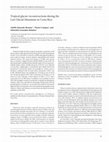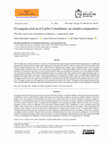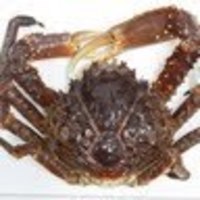Papers by Nestor H Campos Campos
… marinas y costeras, 2002
Four surveys were conducted between October 1998 and April 1999 along the upper section of the Co... more Four surveys were conducted between October 1998 and April 1999 along the upper section of the Colombian Caribbean Sea continental slope with the aim of compliting marine fauna inventories. During the surveys (INVEMAR-MACROFAUNA 1) individuals of the shrimps Parapontocaris caribbaea, P. vicina, Prionocrangon pectinata and Parapontophilus gracilis (Decapoda: Crangonidae) were found and are herein registered for the first time in Colombian waters. Along with the description of the collected material and reference to site of collection, identification keys, diagnostic characters, diagrams and bathimetric and geographic distribution are included as well as comments on morphological variations of the individuals.

Revista Mexicana de Ciencias Geológicas, 2021
Numerous high elevation tropical mountains around the world show evidence of past glacial activit... more Numerous high elevation tropical mountains around the world show evidence of past glacial activity during the Last Glacial Maximum (LGM). Cerro Chirripó in Costa Rica exhibits paleoglacial landforms such as glacial cirques, moraine deposits and polished and striated bedrock surfaces. We used aerial imagery (1:25000) and contour lines to develop a Digital Elevation Model (DEM) for the LGM. We determined paleo-equilibrium line altitudes (paleo-ELAs) using Area-Altitude Balance Ratio (AABR) during the LGM for Cerro Chirripó in Costa Rica. Additionally, a Generalized Linear Model (GLM) was performed to statistically analyze the paleoglacier volumes and ice thickness combined with ten land surface parameters (LSP). Our results identified thirty-one paleoglaciers covering an area of 28.26 km2 during the global LGM, with a maximum ice thickness of 178 meters in Cerro Chirripó, a total volume of 13863 × 105 m3 and a mean paleo-ELA of 3490 meters. In addition, Area and Slope were the LSP wit...
Bulletin of Marine and Coastal Research, 2016
A new range extension of Palicus floridanus and five new records of Palicidae are presented, the ... more A new range extension of Palicus floridanus and five new records of Palicidae are presented, the samples are collected from the Colombian Caribbean coast during the cruise of INVEMAR-Macrofauna I between 1998 and 1999, along the upper continental Slope (300 and 500 m deep). Six species have now been recorded from the area: P. alternatus Rathbun, 1897; P. cursor A. Milne- Edwards, 1880; P. floridanus Rathbun, 1918; P. gracilipes A. Milne-Edwards, 1880; P. gracilis Smith, 1883, and P. sicus A. Milne-Edwards, 1880. Previously, P. alternatus was the only member of the family reported for this area before this study.

Revista de Biología Tropical, 2018
Zooplankton is an important component to understand oceanographic dynamics, they are considered g... more Zooplankton is an important component to understand oceanographic dynamics, they are considered good indicators of environmental variability, since most species are short-lived they can be tight coupling of climate and population dynamics, and some taxa are sensitive to variables such as temperature, quality and quantity of food, oxygenation and stratification. In the Colombian Caribbean two oceanographic cruises were carried out, in order to characterize and analyze the biodiversity of the continental margin, for the periods May-June 2008 and November-December 2009. The objective of this study was to determine which oceanographic variable was the most important in the distribution of zooplankton in the oceanic waters, and how the variables structure the community. In each cruise, zooplankton samples were obtained by vertical hauls with a 1 m2 diameter conical net (200 μm mesh size). The zooplankton community structure was studied by automated image analysis (ZooImage), which combin...
Revista Ciencias Marinas y Costeras, 2016
Durante el desarrollo del proyecto “Caracterización ambiental en el área de interés dentro del bl... more Durante el desarrollo del proyecto “Caracterización ambiental en el área de interés dentro del bloque Guajira Offshore # 3, Caribe colombiano”, se recolectaron ejemplares de Munidopsis bermudezi Chace, 1939. Este es el primer registro de la especie para el mar Caribe colombiano, siendo esta la especie 46 de la superfamilia Galatheoidea registrada para esta región. Es una de las especies cercanas a Munidopsis teretis Baba, 2005, del mar de Tasmania. Se diferencia por la presencia de un par de espinas gástricas conspicuas, la ausencia de un proceso agudo en la región branquial y la ausencia de una carina en la mitad posterior del caparazón. Se presentan la descripción ampliada de la especie y la información sobre su hábitat.
Durante el desarrollo del proyecto “Caracterización ambiental en el área de interés d... more Durante el desarrollo del proyecto “Caracterización ambiental en el área de interés dentro del bloque Guajira Offshore # 3, Caribe colombiano”, se recolectaron ejemplares de Munidopsis bermudezi Chace, 1939. Este es el primer registro de la especie para el mar Caribe colombiano, siendo esta la especie 46 de la superfamilia Galatheoidea registrada para esta región. Es una de las especies cercanas a Munidopsis teretis Baba, 2005, del mar de Tasmania. Se diferencia por la presencia de un par de espinas gástricas conspicuas, la ausencia de un proceso agudo en la región branquial y la ausencia de una carina en la mitad posterior del caparazón. Se presentan la descripción ampliada de la especie y la información sobre su hábitat.

The blue land crab Cardisoma guanhumi is a species of commercial interest and is being harvested ... more The blue land crab Cardisoma guanhumi is a species of commercial interest and is being harvested for human consumption. It is distributed throughout the Caribbean from the Antilles to the southern part in Venezuela and Colombia, with also records in Brazil. The first studies of this crab in Colombia date back to the early 1970s, which focused on biological and ecological aspects. Population studies in the Colombian Caribbean started in 2000, but they are scarce, and some are not published. For San Andrés Island, the Gulf of Urabá, and the Magdalena department, two studies have been done for each one, and for the three studies one is published, and the other is not. Of the unpublished studies, two correspond to graduate studies (Urabá and Magdalena) and one to a technical report (San Andrés). For the Guajira department, there is a published article that mentions some aspects of this crab population. For the department of Atlántico, there is a technical report. Regarding the department of Córdoba, there are two theses. The departments of Bolivar and Antioquia have three studies each. Most of these studies contain information about the sizes and weights of the blue land crab, and some of them also have information on the population density via burrow count. The largest average sizes and weights have been recorded on the island of San Andrés. The highest average population densities have been recorded for Bahía Concha in the department of Magdalena and the lowest for the department of Bolívar in the Corregimiento La Boquilla.
This dataset is described and analyzed in the Data Report "Echinoderms of the Seaflower Bios... more This dataset is described and analyzed in the Data Report "Echinoderms of the Seaflower Biosphere Reserve: state of knowledge and new findings" published in the journal Frontiers in Marine Science 6:188, doi: 10.3389/fmars.2019.00188. The data set comprises the checklist of the echinoderms species from the SeaFlower Biosphere Reserve (SFBR) based on the registers previously published by Borrero-Pérez et al. (2016), peer-reviewed papers or published reports of several investigations, open-access databases and records from unpublished results of samplings conducted in 2011 by Universidad Nacional de Colombia-Sede Caribe and the Seaflower Expeditions 2016 and 2017. A total of 148 echinoderm species were found within the SFBR. Ophiuroidea was the most species-rich class (44 species), followed by Asteroidea (38), Echinoidea (31), Holothuroidea (26) and finally Crinoidea (9).
Bulletin of Marine and Coastal Research, 2016
Four surveys were conducted between October 1998 and April 1999 along the upper section of the Co... more Four surveys were conducted between October 1998 and April 1999 along the upper section of the Colombian Caribbean Sea continental slope with the aim of compliting marine fauna inventories. During the surveys (INVEMAR-MACROFAUNA 1) individuals of the shrimps Parapontocaris caribbaea, P. vicina, Prionocrangon pectinata and Parapontophilus gracilis (Decapoda: Crangonidae) were found and are herein registered for the first time in Colombian waters. Along with the description of the collected material and reference to site of collection, identification keys, diagnostic characters, diagrams and bathimetric and geographic distribution are included as well as comments on morphological variations of the individuals.
Journal of Crustacean Biology, 2000
A new species of porcelain crab, Porcellana lillyae, from the continental shelf of the Caribbean ... more A new species of porcelain crab, Porcellana lillyae, from the continental shelf of the Caribbean coast of Colombia, is described. This new species, the fourth of the genus Porcellana Lamarck currently recognized from the western Atlantic, is most similar to P. sigsbeiana A. Milne-Edwards. The new species is distinguished primarily by the dentate condition of the frontal and lateral margins of the carapace and the presence of spines on the ventral margin of the rostrum. The new species is compared with P. sigsbeiana, and a key to aid in identification of western Atlantic species of the genus is presented.
… marino de Colombia …, 2003
Boletín de …, 2002
... Parapontocaris caribbaea (Boone, 1927) FIGURA 1, A y B. Referencias: Boone, 1927: 125; Dardea... more ... Parapontocaris caribbaea (Boone, 1927) FIGURA 1, A y B. Referencias: Boone, 1927: 125; Dardeau y Heard, 1983: 10; Chace, 1984:30. Material examinado: Ver tabla 2. ... Bogotá. 399p. [ Links ]. 5 Boone, L. 1927. Crustacea from tropical east American seas. ...

Caldasia, Sep 27, 2012
La caracterización de la megafauna de la plataforma y talud superior del Caribe y parte norte del... more La caracterización de la megafauna de la plataforma y talud superior del Caribe y parte norte del Pacífico colombianos, realizada por diferentes exploraciones entre 1998 y 2009, confirma la riqueza específica, abundancia e importancia ecológica de las familias de galateoideos (Munididae y Munidopsidae). Sus especies forman conglomerados que en las partes más someras parecen estar condicionados por la presencia de hábitats particulares como formaciones coralinas de profundidad, a profundidades intermedias por las variaciones más importantes en las características de las masas de agua, y a mayores profundidades por características biológicas de las especies, que les permiten adaptarse a la heterogeneidad ecológica de la costa hasta los 500 m de profundidad. No se observó una relación clara entre la formación de conglomerados de estaciones y la sectorización por ecorregiones propuesta para el mar Caribe colombiano.
Mitochondrial DNA, 2014
Abstract The Caribbean king crab Damithrax spinosissimus (former Mithrax spinosissimus) is a larg... more Abstract The Caribbean king crab Damithrax spinosissimus (former Mithrax spinosissimus) is a large brachyuran in the tropical and subtropical western Atlantic. This is the first report of the complete mitochondrial genome of D. spinosissimus, which was pyrosequenced by FLX 454 technology. The mtDNA encodes for 13 proteins, 22 tRNAs and 2 ribosomal RNAs. In addition, the coding sequences and gene synteny were similar to other previously reported mitogenomes of brachyuran.

En este estudio se caracterizó el estado de las formaciones coralinas en la región de San Antero,... more En este estudio se caracterizó el estado de las formaciones coralinas en la región de San Antero, Caribe colombiano, con base en la cobertura de los principales componentes bentónicos: macroalgas, esponjas, zoantídeos, sustrato duro y corales. Para ello, en febrero y agosto de 2014 se muestrearon tres sectores y siete estaciones localizadas en la región. Para determinar la composición y cobertura de cada componente bentónico se empleó el método de fototransecto utilizando el programa Coral Point Count (CPCe.v4.1). Las fotografías fueron tomadas sobre cuadrantes de 0,25 x 0,25 m colocados consecutivamente a lo largo de bandas de 20 x 0,25 m. Se registraron 16 especies de corales (15 escleractinios y un milleporino). El coral fue la categoría más importante en términos de cobertura (45,4 %), seguido de macroalgas (24,3 %) y sustrato abiótico (20,4 %). Los sectores que registraron las mayores coberturas coralinas fueron Punta Bello (51,8 %) y Punta Bolívar (44,4 %), en tanto que la cob...
Caldasia, Oct 24, 2012
Resumen Se registran nueve especies de cangrejos ermitaños del género Paguristes para la costa Ca... more Resumen Se registran nueve especies de cangrejos ermitaños del género Paguristes para la costa Caribe colombiana; P. paraguanensis había sido registrada previamente para la región de la Guajira. Las ocho especies restantes son nuevos registros para el Caribe colombiano y dos de estas, P. zebra y P. werdingi, son nuevas especies. La primera procede de la Bahía de Cartagena y las Islas del Rosario; la segunda tiene una distribución más amplia,

Acta Biologica Colombiana, Oct 1, 2010
A spatial scale study of decapods crustacean associated with algal assemblages was conducted at M... more A spatial scale study of decapods crustacean associated with algal assemblages was conducted at Moñitos, Puerto Escondido and Los Córdobas, Colombian Caribbean. During September of 2006 and June of 2007 were realized four samplings in five station; two in Moñitos, two in Puerto Escondido and one in Los Cordobas. A quarter of 625 cm2 was used to collect the species with five repetitions which were chosen at random, in each station. To separate the macroalgae from hold fast, it was used palette knife. The decapods crustaceans were separate in a plastic recipient, and those were preserved in alcohol at 70%, in bottles of plastic which were carefully named. 27 species of decapods associated with algae assemblages were reported, grouped in 13 families and 19 genera. Hippolyte pleuracanthus was registered for first time for the Colombian Caribbean. According to the classification analyses (UPGMA), it was found that the structure of the decapods crustacean were related with characteristic rocky line and algae assemblages, indicating that the differences in the population were consequences of a spatial patterns. The results indicated that of the 27 species identified, Epialtus bituberculatus recorded the highest percentage of abundance (65.7%), followed by Pachygrapsus transversus (6.2%), Eurypanopeus abbreviatus (3.8%), Acanthonyx petiverii, Panopeus sp1. (3.6%) and Panopeus sp2. (3.4%). The rest of the species provided an abundance ≤ 2.2%.
Boletin De Investigaciones Marinas Y Costeras Invemar, Jul 1, 2008











Uploads
Papers by Nestor H Campos Campos